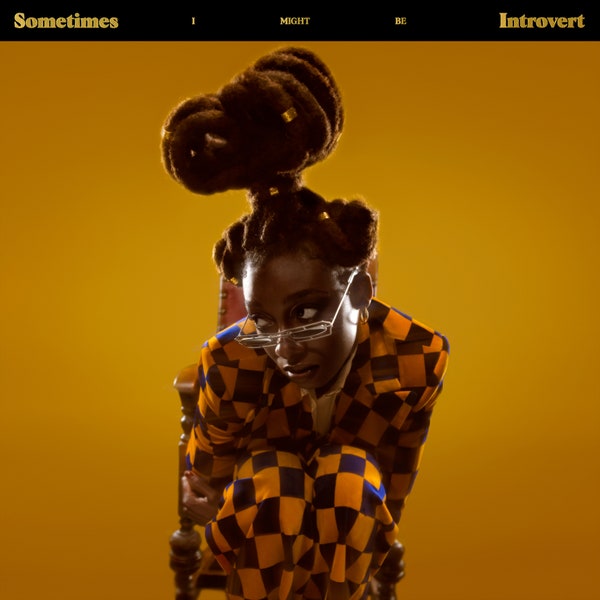National Music Reviews
Little Simz
Sometimes I Might Be Introvert
AGE 101 MUSIC
Street: 09.03
Little Simz = Stormzy + Lauryn Hill
Simbi Ajikawo, known popularly as Little Simz, assigns listeners homework in order to fully understand her new album, Sometimes I Might Be Introvert. The album flows from one song, one theme, one rhyme to the next so sensibly that Simz adds herself to the list of glowing women she rhymes about on “Woman.” Every aspect of this album is marinated with intention, starting with the cover art: Gradient amber weighted with the luster of pure gold surrounds Simz, as if she sits in a room lit solely by herself and the precious metal. Yellow and blue are both staple colors in kente cloth, a traditional African textile, along with loud patterns and contrasting colors.
Simz offers a minimalistic nod to her Black heritage not only through the use of colors and patterns, but also with her hairstyle. R&B icons throughout history have referenced Black history in their cover art—Erykah Badu’s Mama’s Gun cover comes to mind with its earthy green, golden yellow and dusted red. Thus, another nod from Simz to her heritage as a female R&B artist. Despite all references, nods and inspirations, this album is entirely Simbi Ajikawo’s. Through painful honesty, durable strength and exceptional writing, Sometimes I Might Be Introvert is worth the slow ride and the deep dive.
Sometimes I Might Be Introvert opens with a rush of snares, horns and a choir rallying soldiers as they enter the battlefield: flags, dignity and cannons untethered and ready for the fight. From yin vs. yang to “Simz the artist or Simbi the person” to working vs. living, Little Simz shares her own internal battles. This becomes a theme for the album, amplified by spelling out “SIMBI” with the first letter of each word in the album title.
She ends opening track “Introvert” with the words “… As you embark on a journey / Of what it takes to be a woman.” This last line begs the question: What does it take to be a woman? Ajikawo answers through rhymes, referencing women in different cultures and describing their unique feminine light. Feminism and female empowerment can sometimes come off as rehearsed, fake or simply counteractive, but “Woman” empowers women authentically by focusing on all the beautiful aspects of femininity without a single mention of a man.
A Smokey Robinson sample on “Two Worlds Apart,” solidifies the recognizable R&B influence on other tracks, such as “Miss Understood” and “How Did You Get Here,” dipping in and out throughout the album. Simz pries her heart wide open for listeners on this album, whether she’s unpacking the turbulent relationship with her father or delivering diary-like self-doubts on the honest love ballad “I See You.” Horns begin to build during “I Love You, I Hate You” as she questions, “Will the pressure take me to new heights or be my demise?,” somehow making the listener feel exactly what the rapper feels: fear of the unknown, discomfort of the unanswerable.
Despite the unfiltered expression of doubts, pain and fear, Little Simz is sure to remind listeners of her well-deserved success and skills for hard rap. After a mid-album recharge on “Gems (Interlude),” the artist snaps into a confident tone. “Standing Ovation” makes a triumphant victory lap reminiscent of hard times, and “Rollin Stone” leans into the infamous rapper’s ego with a trapper’s beat. At the end of “Standing Ovation,” she shouts out all the hard workers in our society who rarely get the credit they deserve. Even in her boasting, Simz’ heart for humanity is easily recognizable.
The five interludes scattered throughout the album provide insight and storytelling, a tool that legends like Kendrick Lamar and Kanye West have employed in past albums. “Gems – Interlude,” offers little gems, or reminders. Placed in the heart center of the album, this interlude centers and grounds the project around the whirlwind of emotions the artist expresses.
I found myself replaying “Gems (Interlude)” to keep reminders for myself, but my personal favorite of the interludes is “The Rapper That Came to Tea (Interlude),” a play on words referencing the children’s story The Tiger Who Came to Tea. Simz’ alter-ego prods, “The extroverts like to be entertained and I was told you don’t talk much … What’s a girl like you want in a place like this?” She asks herself questions with no sure answer. “Little Q, Pt. 1 (Interlude)” and “Little Q, Pt. 2” bring another level of vulnerability as Little Simz addresses her cousin who she grew apart from with age but keeps close to her heart.
There’s some truly outstanding tracks on Sometimes I Might Be Introvert and there’s some not bad but forgettable tracks as well. African influence dances loud and clear across “Fear No Man,” “Point and Kill,” magnified by the use of color and pattern in the cover art. Little Simz’ unshakeable talent lies in her writing skills as she juggles the life of a rapper and the life of a regular, introverted human. In order to truly appreciate this project, do your homework and read the lyrics. Not only will you understand the album, but you will be able to appreciate her incredible talent for writing and rhyming. Little Simz is the next female rap/R&B legend and she (humbly) knows it. – Harper Booth



